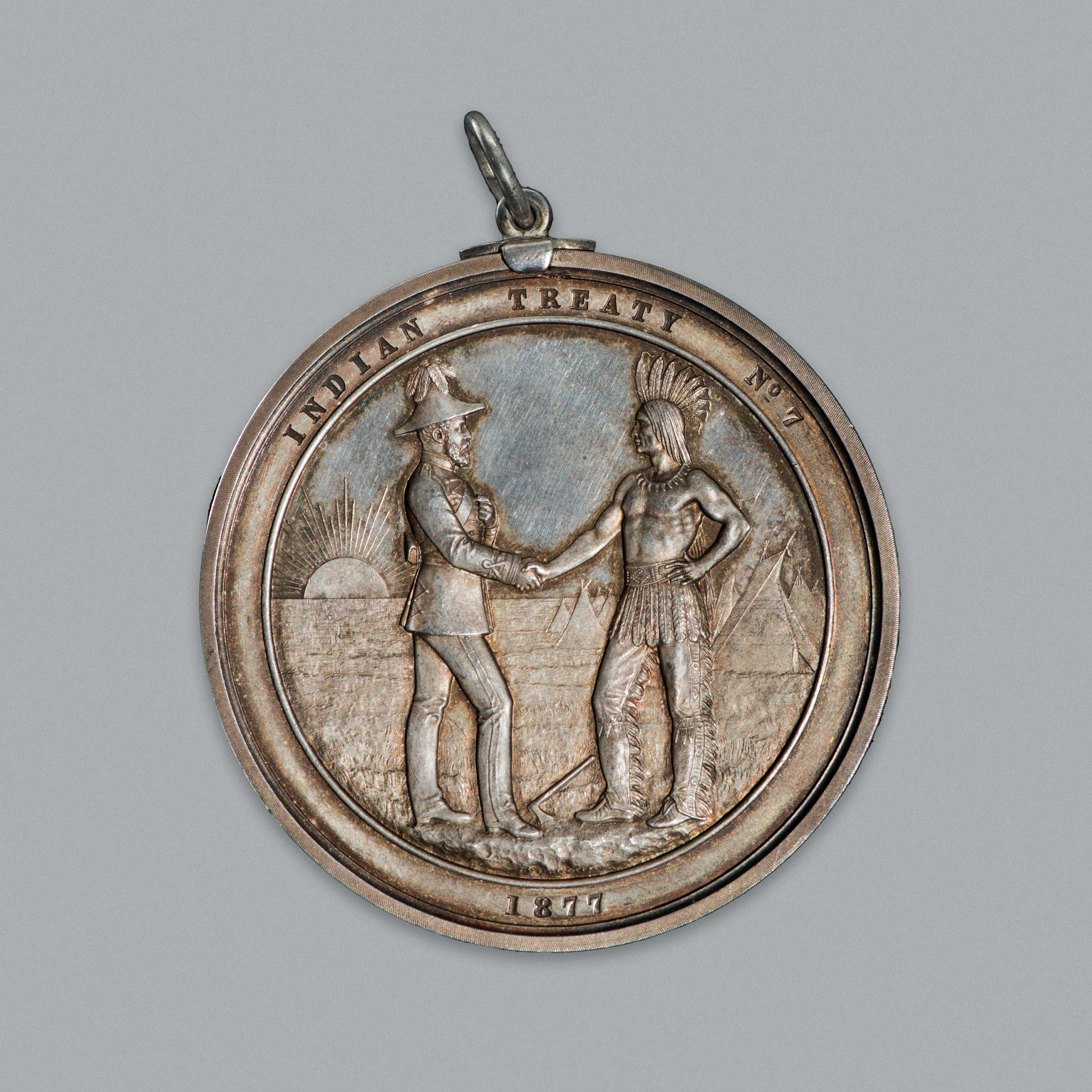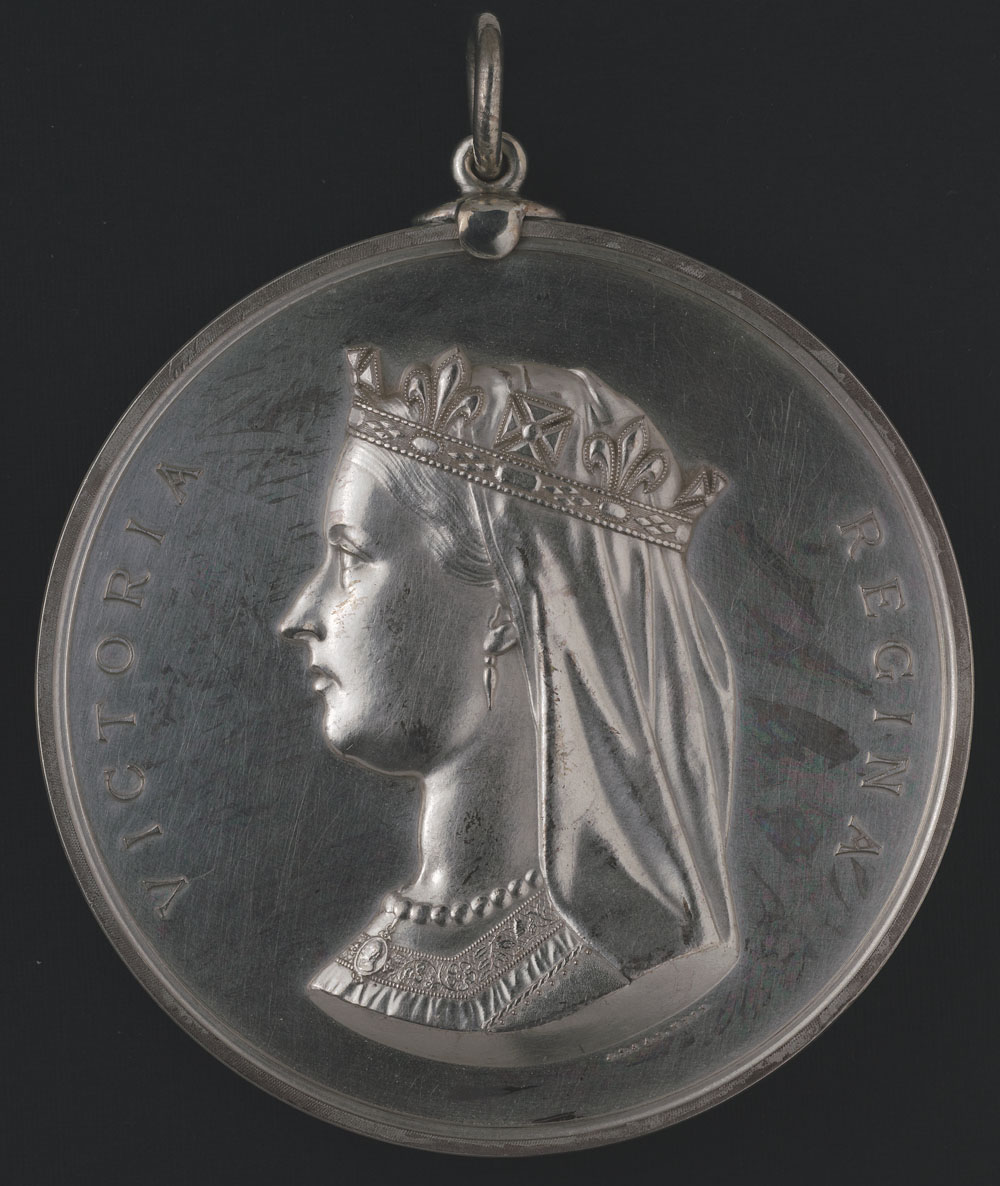Unstamped Treaty Medal
Artifact
Image
Video
Audio
 Activities
Activities
LOOK
Look closely at this medal and complete the following sentences:
- I see… [Describe what you see on the medal.]
- I think… [What do you think the medal is representing?]
- I wonder… [What questions do you have about the medal?]
DO
Is your school located on treaty land? Do some external research to find out what treaty – if any – you are a part of. What are the key rights outlined in the treaty?
Details
 Materials
Materials - Silver
Historical Context
Choose one of the three levels below to match your needs.
- This medal is one of several that the Canadian government commissioned in 1873 to present to Indigenous chiefs when a treaty was agreed upon.
- The inscription reads “INDIAN TREATY N°. _ / 187_,” with two blank spaces so that the treaty number and year could be stamped on.
- Between 1870 and 1877, Plains First Nations negotiated seven treaties with the Canadian government. Each side understood the treaties differently. Many promises were ignored, broken or forgotten over the years. To this day, Indigenous communities are fighting to have their treaty rights honoured and the treaty relationship restored.
Scroll through the media carousel above to see a picture of the reverse side of the treaty medal.
This medal is one of several that the Canadian government commissioned in 1873. The inscription on the reverse reads “INDIAN TREATY N°. _ / 187_,” with two blank spaces so that the treaty number and year could be stamped at the time of presentation to an Indigenous chief or headman.
Between 1870 and 1877, Plains First Nations negotiated seven treaties with the Canadian government. These First Nations understood treaties as alliances of peace, friendship and mutual support. The Canadian government understood treaties as a means of acquiring land for a transcontinental railway, settlement, agriculture and resource extraction.
In exchange for these traditional territories, government representatives made promises to First Nations that were recorded in both the written and oral versions of treaties. These included rights to reserve lands and cash payments, as well as to equipment for hunting, fishing and farming. Many of these promises were ignored, broken or forgotten over the following years. To this day, Indigenous communities are fighting to have their treaty rights honoured and the treaty relationship restored.
This medal is one of several that the Canadian government commissioned in 1873 from engravers Joseph, Alfred and Allan Wyon of London, England, at a cost of $24 per medal. The obverse bears the profile image of Queen Victoria, and the Latin inscription “VICTORIA REGINA.”
The reverse features the image of a British officer shaking hands with a stereotypical Plains First Nations man. At their feet lies a hatchet, ready to be buried. The inscription on the reverse reads “INDIAN TREATY N°. _ / 187_,” with two blank spaces so that the treaty number and year could be stamped at the time of presentation to an Indigenous leader.
Between 1870 and 1877, Plains First Nations negotiated seven treaties with the Canadian government. These First Nations understood treaties as alliances of peace, friendship and mutual support. Treaties, they believed, would ensure their survival and security in an uncertain future.
The Canadian government understood treaties differently. In the government’s view, treaties were a means of acquiring land for a transcontinental railway, settlement, agriculture and resource extraction. The commissioning of treaty medals with blank spaces suggests that, for the Canadian government, the Dominion’s expansion westward was a given.
In exchange for these traditional territories, government representatives made promises to First Nations that were recorded in both the written and oral versions of treaties. These included the right to reserve lands and cash payments, as well as the right to equipment for hunting, fishing and farming.
Many of these promises were ignored, broken or forgotten over the ensuing years. To this day, Indigenous communities continue to fight to have their treaty rights honoured and the treaty relationship restored.
- This medal is one of several that the Canadian government commissioned in 1873 to present to Indigenous chiefs when a treaty was agreed upon.
- The inscription reads “INDIAN TREATY N°. _ / 187_,” with two blank spaces so that the treaty number and year could be stamped on.
- Between 1870 and 1877, Plains First Nations negotiated seven treaties with the Canadian government. Each side understood the treaties differently. Many promises were ignored, broken or forgotten over the years. To this day, Indigenous communities are fighting to have their treaty rights honoured and the treaty relationship restored.
Scroll through the media carousel above to see a picture of the reverse side of the treaty medal.
This medal is one of several that the Canadian government commissioned in 1873. The inscription on the reverse reads “INDIAN TREATY N°. _ / 187_,” with two blank spaces so that the treaty number and year could be stamped at the time of presentation to an Indigenous chief or headman.
Between 1870 and 1877, Plains First Nations negotiated seven treaties with the Canadian government. These First Nations understood treaties as alliances of peace, friendship and mutual support. The Canadian government understood treaties as a means of acquiring land for a transcontinental railway, settlement, agriculture and resource extraction.
In exchange for these traditional territories, government representatives made promises to First Nations that were recorded in both the written and oral versions of treaties. These included rights to reserve lands and cash payments, as well as to equipment for hunting, fishing and farming. Many of these promises were ignored, broken or forgotten over the following years. To this day, Indigenous communities are fighting to have their treaty rights honoured and the treaty relationship restored.
This medal is one of several that the Canadian government commissioned in 1873 from engravers Joseph, Alfred and Allan Wyon of London, England, at a cost of $24 per medal. The obverse bears the profile image of Queen Victoria, and the Latin inscription “VICTORIA REGINA.”
The reverse features the image of a British officer shaking hands with a stereotypical Plains First Nations man. At their feet lies a hatchet, ready to be buried. The inscription on the reverse reads “INDIAN TREATY N°. _ / 187_,” with two blank spaces so that the treaty number and year could be stamped at the time of presentation to an Indigenous leader.
Between 1870 and 1877, Plains First Nations negotiated seven treaties with the Canadian government. These First Nations understood treaties as alliances of peace, friendship and mutual support. Treaties, they believed, would ensure their survival and security in an uncertain future.
The Canadian government understood treaties differently. In the government’s view, treaties were a means of acquiring land for a transcontinental railway, settlement, agriculture and resource extraction. The commissioning of treaty medals with blank spaces suggests that, for the Canadian government, the Dominion’s expansion westward was a given.
In exchange for these traditional territories, government representatives made promises to First Nations that were recorded in both the written and oral versions of treaties. These included the right to reserve lands and cash payments, as well as the right to equipment for hunting, fishing and farming.
Many of these promises were ignored, broken or forgotten over the ensuing years. To this day, Indigenous communities continue to fight to have their treaty rights honoured and the treaty relationship restored.
Summary
- This medal is one of several that the Canadian government commissioned in 1873 to present to Indigenous chiefs when a treaty was agreed upon.
- The inscription reads “INDIAN TREATY N°. _ / 187_,” with two blank spaces so that the treaty number and year could be stamped on.
- Between 1870 and 1877, Plains First Nations negotiated seven treaties with the Canadian government. Each side understood the treaties differently. Many promises were ignored, broken or forgotten over the years. To this day, Indigenous communities are fighting to have their treaty rights honoured and the treaty relationship restored.
Scroll through the media carousel above to see a picture of the reverse side of the treaty medal.
Essential
This medal is one of several that the Canadian government commissioned in 1873. The inscription on the reverse reads “INDIAN TREATY N°. _ / 187_,” with two blank spaces so that the treaty number and year could be stamped at the time of presentation to an Indigenous chief or headman.
Between 1870 and 1877, Plains First Nations negotiated seven treaties with the Canadian government. These First Nations understood treaties as alliances of peace, friendship and mutual support. The Canadian government understood treaties as a means of acquiring land for a transcontinental railway, settlement, agriculture and resource extraction.
In exchange for these traditional territories, government representatives made promises to First Nations that were recorded in both the written and oral versions of treaties. These included rights to reserve lands and cash payments, as well as to equipment for hunting, fishing and farming. Many of these promises were ignored, broken or forgotten over the following years. To this day, Indigenous communities are fighting to have their treaty rights honoured and the treaty relationship restored.
In-Depth
This medal is one of several that the Canadian government commissioned in 1873 from engravers Joseph, Alfred and Allan Wyon of London, England, at a cost of $24 per medal. The obverse bears the profile image of Queen Victoria, and the Latin inscription “VICTORIA REGINA.”
The reverse features the image of a British officer shaking hands with a stereotypical Plains First Nations man. At their feet lies a hatchet, ready to be buried. The inscription on the reverse reads “INDIAN TREATY N°. _ / 187_,” with two blank spaces so that the treaty number and year could be stamped at the time of presentation to an Indigenous leader.
Between 1870 and 1877, Plains First Nations negotiated seven treaties with the Canadian government. These First Nations understood treaties as alliances of peace, friendship and mutual support. Treaties, they believed, would ensure their survival and security in an uncertain future.
The Canadian government understood treaties differently. In the government’s view, treaties were a means of acquiring land for a transcontinental railway, settlement, agriculture and resource extraction. The commissioning of treaty medals with blank spaces suggests that, for the Canadian government, the Dominion’s expansion westward was a given.
In exchange for these traditional territories, government representatives made promises to First Nations that were recorded in both the written and oral versions of treaties. These included the right to reserve lands and cash payments, as well as the right to equipment for hunting, fishing and farming.
Many of these promises were ignored, broken or forgotten over the ensuing years. To this day, Indigenous communities continue to fight to have their treaty rights honoured and the treaty relationship restored.


